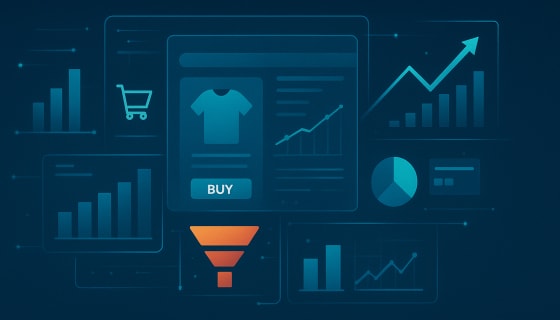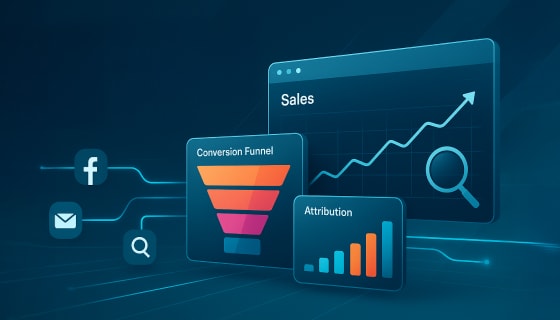Agencies today don’t need to be in the business of building data systems from scratch. They don’t need to hire data experts or buy expensive software; instead, they’re turning to white-label data analytics for business, and for good reason. White-label services enable agencies to focus on creative work, client relationships, and strategy while providing clients with high-quality data insights they crave. It’s fast, it’s efficient, and it cuts through the clutter.
In this blog, we’re diving into why white-label data analytics is the solution that agencies can’t afford to ignore. We’ll explore how it saves time, boosts client satisfaction, and makes agencies more competitive. Stick around—we’ve got the scoop on why you should seriously consider white-label data analytics to future-proof your agency.
Why Agencies Are Falling Short Without Data Analytics
Agencies today face increasing pressure to deliver measurable results, optimize campaigns, and provide actionable insights to their clients. In the midst of all this, data analytics has become the driving force behind every impactful marketing campaign. While it may seem tempting to build an in-house data team, managing data analytics can be overwhelming for most agencies.
Here are the core challenges agencies face when managing data in-house:
- Time-Consuming Processes: Gathering, cleaning, and analyzing data requires a significant time investment, often pulling focus away from core business activities.
- High Resource Demands: Agencies must hire experienced data analysts and data scientists, as well as invest in expensive tools and software, which adds unnecessary overhead costs.
- Accuracy and Consistency Issues: Without the proper infrastructure, agencies often encounter inconsistent data, resulting in errors and poor decision-making, which can directly impact campaign outcomes.
Even if agencies manage to establish a data team, they still face the challenge of maintaining accuracy and consistency. Data can be messy, incomplete, or siloed across multiple platforms, resulting in errors that impact decision-making. The hidden cost of not having access to key insights is far greater than most agencies realize. Missed opportunities to optimize campaigns result in wasted ad spend and lost sales opportunities, ultimately impacting client satisfaction. When clients don’t see the results they expect, they’re less likely to renew contracts or recommend your agency to others.
Clients have high expectations, and they want to know exactly where their marketing budget is going and what kind of return they’re getting. If an agency is unable to provide actionable insights, leveraging white-label data analytics services can help agencies scale and meet these growing demands without incurring additional costs.
The Power of White-Label Data Analytics
White-label data analytics enables agencies to offer advanced data services under their brand without the need to invest in the infrastructure or expertise required to build them in-house. Essentially, a white-label provider handles the technical side of data analytics while the agency focuses on delivering value to its clients.
Agencies can now compete with larger firms that have dedicated in-house teams without the burden of massive operational costs or long timelines. Here are the key benefits that come with white-label analytics:
- Cost-Efficiency: Hiring a full-fledged data team and purchasing sophisticated tools can be an expensive venture. With white-label analytics, agencies pay only for the services they use, significantly reducing overhead costs. Agencies can access enterprise-level data analytics without requiring significant capital investment.
- Expertise Without the Overhead: Data analytics requires specialized skills, from data collection and cleaning to advanced analysis and interpretation. With white-label services, agencies can have teams of experienced data scientists, analysts, and engineers without incurring the costs associated with hiring and training.
- Scalability: As your agency grows, so do your analytics needs. White-label analytics solutions provide the flexibility to scale, allowing you to start small and expand as needed. There’s no need to worry about hiring more data scientists or purchasing additional tools as you take on more clients or projects.
- Faster Turnaround: With a white-label provider managing data analytics, agencies can deliver timely reports and insights to clients, avoiding delays. Clients appreciate fast, actionable insights, which can be the difference between making a campaign adjustment or wasting ad spend.
- Seamless Integration: White-label providers work behind the scenes, integrating easily with your agency’s existing workflows and platforms. You can integrate advanced analytics tools into your existing systems and processes, ensuring a seamless transition and improved overall efficiency.
One of the reasons many agencies choose to work with white-label providers is the variety of hiring models available to match different needs:
With these advantages, it’s clear why more agencies are turning to white-label data analytics, allowing them to focus on what they do best while still offering clients the insights they need to stay ahead of the competition.
How Analytics Changes Your Digital Marketing Offerings
In any organization, digital marketing services are the driving force behind online growth and brand presence. By harnessing the power of data, marketing teams can maximize ROI, optimize campaigns in real-time, and ensure they’re always on the right track. However, the real power of data lies in its ability to enhance the core pillars of digital marketing—SEO, PPC, and social media—each relying on data to fuel success in its unique way.
- SEO (Search Engine Optimization) Optimization: Data analytics helps marketing teams track how keywords perform over time, understand user behavior on-site, and identify what drives engagement. By measuring key metrics, teams can refine their content strategies and focus on what truly resonates with the target audience. Analytics makes it easy to adjust on-page SEO (like meta tags and keyword usage) and off-page SEO (like backlinks), ensuring that your content gets maximum visibility and drives more qualified traffic.
- PPC (Pay-Per-Click) Campaigns: PPC campaigns are all about budget efficiency and ensuring that every dollar spent on ads yields a high return on investment. Analytics enables marketing teams to track the performance of keywords, ad copy, and targeting strategies. By monitoring these metrics, teams can continually optimize bids, refine ad placements, and adjust targeting to achieve more effective cost-per-conversion ratios. Through A/B testing and data segmentation, teams can ensure that campaigns continually improve for maximum ROI.
- Social Media Campaigns: Social media is one of the richest sources of data for digital marketing teams. Through data analytics, teams can track engagement rates, audience demographics, sentiment analysis, and conversion rates from social media platforms. Analytics also help identify trends and patterns in user behavior, enabling teams to refine their strategies and ensure that campaigns align with audience preferences.
Data analytics in digital marketing helps deliver actionable insights from data that drive growth, increase efficiency, and boost ROI. With the right data tools, marketing teams can optimize their SEO, PPC, and social media strategies to ensure maximum impact across every channel.
POCs (Proof of Concepts) for White-Label Data Analytics Services
When agencies partner with a white-label data analytics provider, the process of delivering practical and actionable insights follows a structured approach. This begins with understanding the client’s needs and progresses through several key stages to ensure the highest level of data-driven value.
Let’s break down the five essential steps in delivering white-label data analytics services:
Step 1: Onboarding a New Client
The first step in providing white-label data analytics is to thoroughly understand the client’s specific needs. Each client has unique goals, and knowing exactly what they want to achieve allows the agency to create a tailored strategy. This step ensures that the correct data is collected and the proper insights are targeted from the outset.
Here’s how agencies approach this phase:
- Client objectives: Understanding what the client aims to achieve with their data.
- Current data landscape: Determining what data the client already has. What tools are they using, and how is the data currently being tracked or stored?
- Success metrics: Identifying clear KPIs that define success for the client, making it easier to measure the effectiveness of the analytics.
This foundational step ensures that everything going forward is aligned with the client’s expectations.
Step 2: Collecting and Structuring Data for Effective Analysis
After understanding the client’s needs, the next step is to gather and organize the data to ensure it’s clean, structured, and ready for analysis. In this step, agencies will transform raw data into something that can be analyzed effectively and aligned with the client’s goals. The importance of this stage is evident: structured data is the foundation for accurate insights.
- Data extraction: Pulling data from various platforms such as websites, CRMs, social media, and paid advertising accounts.
- Data cleaning: Removing inconsistencies, duplicates, and irrelevant information to ensure the data is reliable and accurate.
- Data organization: Structuring the data in a way that makes sense for the client’s goals, whether that’s by campaigns, customer segments, or specific metrics.
This step ensures that the data is both clean and accessible, allowing agencies to extract meaningful insights moving forward.
Step 3: Developing Custom Dashboards and Reports for Clients
Once the data is structured, it’s time to create custom dashboards and reports that present the data in a clear and easily digestible format. This enables both agencies and clients to quickly access the insights they need without being bogged down in complex datasets. Custom reports and dashboards turn raw numbers into visual stories.
Here’s how this step is carried out:
- Personalized dashboards: Crafting dashboards that are user-friendly and focused on the client’s most important metrics and KPIs.
- Automated reporting: Setting up automated reports that deliver regular insights without manual intervention, saving time.
- Data visualizations: Using graphs, charts, and heatmaps to make complex data clear and actionable.
With these tools, clients can view real-time data and track their performance, ensuring they’re always informed.
Step 4: Real-Time Monitoring and Adjustments Based on Analytics
The power of data analytics lies in its ability to inform real-time decisions. This step is where agencies can start actively monitoring campaigns and making real-time adjustments. Instead of waiting for reports at the end of the month, real-time data enables agencies to act immediately, optimizing performance and reducing waste.
Here’s how the real-time process works:
- Continuous Campaign Monitoring: Continuously track the performance to ensure strategies are on track to meet their goals.
- Real-Time Issue Identification: Identify issues or opportunities as they arise and make timely adjustments to optimize results.
- A/B and Multivariate Testing: Test hypotheses through A/B testing or multivariate testing to identify the most effective strategies.
This step helps maintain agility and ensures that campaigns are constantly improving, delivering the best possible outcomes for the client.
Step 5: Delivering Actionable Insights and Recommendations
The final step in the process involves transforming data into actionable insights. Insights alone aren’t enough; agencies must provide clear recommendations that drive fundamental improvements. This phase ensures that the data translates into practical steps the client can take to further enhance their marketing efforts.
What this step involves:
- Strategic recommendations: Offering next steps based on insights, such as optimizing an ad copy or revising a landing page.
- Continuous improvement: Creating refinement strategies that make use of insights over time, ensuring campaigns evolve with market trends.
- ROI tracking: Demonstrating how data-driven decisions are leading to measurable improvements in the client’s bottom line.
This step shows the direct impact of data analytics on a client’s success, turning insights into tangible, actionable strategies.
The Technical Side of White-Label Data Analytics
One of the prime advantages of outsourcing data analytics through white-label services is the ability to reduce costs associated with expertise and infrastructure. With white-label analytics, agencies don’t need to hire full-time experts or invest in expensive software.
A significant part of delivering quality white-label data analytics is the ability to use advanced tools that provide meaningful insights. Here are the essential analytics platforms agencies should be familiar with:
- Power BI: A popular data visualization tool that allows agencies to create interactive dashboards and reports, presenting data in a clear and easily digestible format.
- Looker Studio: A powerful business intelligence platform that allows agencies to turn data into actionable insights, facilitating better decision-making and improved client reporting.
Click here to get a complete guide on building a dashboard on Power BI or Looker Studio. - Tableau: Known for its ability to turn complex data into visually appealing and interactive reports, Tableau allows agencies to drill down into performance metrics, uncover trends, and deliver powerful insights to clients.
These platforms provide agencies with the tools they need to collect, analyze, and present data in a way that’s both understandable and actionable for clients. In white-label data analytics, there are three key types of data support experts who work together to make sense of the data and drive results for clients.
Here’s a breakdown:
| Expertise | Definition | Expertise Needed |
| Data Scientist | Specializes in advanced data analysis and predictive modeling | Deep knowledge of statistical analysis, machine learning, and big data processing. |
| Data Engineer | Focuses on data collection, cleaning, and integration | Strong skills in data pipeline construction, ETL processes, and database management. |
| Data Analyst | Analyzes data to produce insights and reports | Expertise in data visualization, reporting tools, and business intelligence. |
Another benefit of white-label data analytics is its ability to integrate seamlessly with the existing platforms agencies are already using. Whether it’s a CMS (Content Management System) or CRM (Customer Relationship Management) platform, analytics integration helps agencies streamline workflows by connecting data across platforms without disrupting existing systems. It also improves efficiency by ensuring that data collected through various channels can be accessed and analyzed in a single, centralized location.
While the technical aspects of custom data analytics solutions offer significant benefits, they also present their own set of challenges. But with the right strategies in place, these hurdles are manageable.
Overcoming Common Barriers in Implementing Data Analytics at Scale
While data analytics can provide invaluable insights, scaling these efforts across an agency is no easy feat. Agencies often face several challenges that make it difficult to implement data analytics at scale effectively. Here are the primary barriers:
- Addressing Data Silos and Integration: Data is often scattered across various systems, platforms, and departments within an organization, making it challenging to obtain a comprehensive, unified view of client performance. Integration of data from different sources can be complex and time-consuming, often requiring manual workarounds and increasing the risk of errors. Without the proper integration tools, agencies cannot effectively combine data, resulting in gaps in their understanding of customer behavior, campaign effectiveness, and sales performance.
- Ensuring Data Quality and Consistency for Clients: Data quality is another common barrier agencies face. Inaccurate, incomplete, or outdated data can lead to flawed analysis, which in turn impacts the overall effectiveness of campaigns. Agencies often struggle with standardizing data across various platforms, particularly when handling large datasets from multiple sources. Poor data quality not only compromises the integrity of analytics but can also harm client relationships, as decision-makers may question the value of data-driven recommendations that aren’t based on reliable information.
- Building a Data-Driven Agency Culture: Even if agencies have access to the correct data and tools, they often fail to establish a data-driven culture within their organization. This can result in teams working in silos, with departments using data for their purposes but not collaborating or aligning on company-wide data strategies. Transitioning to a data-driven culture requires leadership buy-in, ongoing training, and a clear understanding of how data can inform marketing strategies across every department. Without a data-driven mindset, agencies may overlook the potential of data to improve decision-making and campaign performance.
Although the challenges we’ve highlighted are common across the industry, the right solutions have the power not only to overcome them but also to turn them into opportunities for growth and optimization.
Challenges vs. Solutions in Scaling Data Analytics
| PROBLEM | DESCRIPTION | SOLUTION |
| Data Silos | Data is scattered across different systems, leading to fragmented insights. | Utilize centralized platforms to consolidate data from all sources, facilitating consistent analysis. |
| Inconsistent Data Quality | Poor data quality is impacting decision-making and reporting. | Implement automated data validation and cleaning tools to ensure the reliability and high quality of data. |
| Lack of a Data-Driven Culture | Limited adoption of data insights within teams results in a reliance on intuition. | Foster a data-driven mindset through employee training and data accessibility across the team. |
By tackling these challenges with the right tools and strategies, agencies can maximize the benefits of data analytics and achieve tangible, lasting results.
The Future of White-Label Data Analytics for Agencies
As the digital landscape evolves, AI and automation will continue to revolutionize how agencies use white-label data analytics. These innovations are not only making data processing faster but also more intelligent, empowering agencies to deliver results more efficiently. Here’s how the future is shaping up:
- Predictive Analytics: With the help of AI, agencies will be able to forecast trends in consumer behavior and predict the future of their business, thereby anticipating market needs and making proactive decisions.
- Automated Insights: With automation, agencies can generate real-time reports and AI-generated recommendations that automatically highlight areas of improvement.
- Personalization at Scale: AI will enable agencies to tailor content and ads based on each individual’s behavior, thereby increasing engagement and conversions by delivering the right message at the right time.
As we wrap up, you should look forward to partnering with a white-label data analytics provider today to anticipate the future and position your agency for long-term success.
Conclusion
Ultimately, white-label data analytics is about making your agency more efficient, scalable, and competitive. It provides access to cutting-edge insights and expert-level data analysis, eliminating the need for costly hires or complex systems. You get all the power of data analytics at a fraction of the cost and effort.
Consider partnering with ZealousWeb to gain a strategic edge. Our in-house data experts will take the load off your shoulders, letting you focus on growing your business, serving your clients, and delivering results that matter. The future is all about data, and by embracing white-label analytics, you’re setting your agency up for sustained growth and long-term success.













